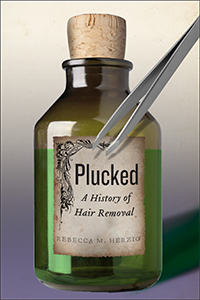Many women spend countless hours and large sums of money to get rid of unwanted hair. From our eyebrows all the way to our toes, there is not a single part of the female body that has not been subjected to plucking in some form or another. How many of us have stopped to consider why we are doing this in the first place?
 The North American hair removal tradition might not have started as far back as, say, in the Middle East, but it is rich enough to make this book fascinating. It started with colonial America’s clamshell razors and homemade depilatories to modern day diode lasers and prescription pharmaceuticals, between which a large array of tools to remove hair deemed unsightly, unnatural, or excessive have been used with an almost frenzied dedication. Unsurprisingly, 99% of American women have tried hair removal, and at least 85% regularly remove hair from their faces, armpits, legs, and bikini lines.
The North American hair removal tradition might not have started as far back as, say, in the Middle East, but it is rich enough to make this book fascinating. It started with colonial America’s clamshell razors and homemade depilatories to modern day diode lasers and prescription pharmaceuticals, between which a large array of tools to remove hair deemed unsightly, unnatural, or excessive have been used with an almost frenzied dedication. Unsurprisingly, 99% of American women have tried hair removal, and at least 85% regularly remove hair from their faces, armpits, legs, and bikini lines.
But why? How and when does hair become a problem? What makes some growth “excessive”? What separates the necessary from the superfluous?
In Plucked: A History of Hair Removal, historian Rebecca Herzig shows how dominant American beliefs about visible hair changed. Did you know that elective hair removal used to be considered a “mutilation” practiced primarily by “savage” men? It is only recently that hair-free faces and limbs were expected of women. Visible hair growth, especially on young, white women, came to be perceived as a sign of political extremism, sexual deviance, or mental illness. No wonder so many Americans are waxing, threading, shaving, or lasering the hair off their bodies, but not without collateral damage.
In our attempts to understand the difference between real beauty and impossible beauty, the line between what we think is beautiful and what actually is beautiful can be quite blurry. Is hair on women’s bodies truly ugly? Are so many American women getting rid of theirs in a justified bid to achieve real beauty? Or have they all been brainwashed into believing that they cannot be beautiful with any semblance of hair on their bodies? The answer is very complex, and requires an understanding of where the current standards of beauty have emerged from. Books like Plucked contribute to the all-important discourse on beauty, which is slowly leading us to a understand how complex it really is—and perhaps that there is a space for woman to sport bodily hair after all.
